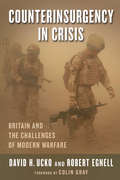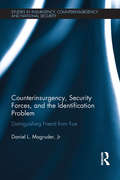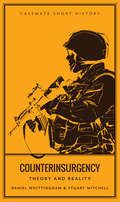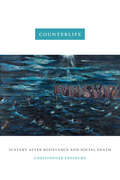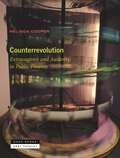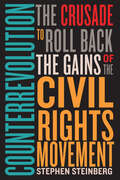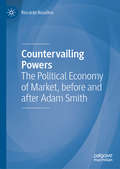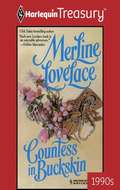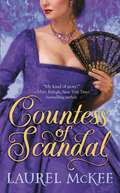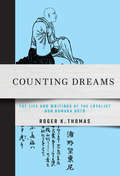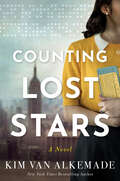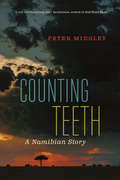- Table View
- List View
Counterinsurgency Warfare: Theory and Practice
by David GalulaThis book provides an analysis of how to countermand insurgency and the elements that might hinder its defeat. Inspired by his military experiences as a French military officer and attache in China, Greece, Southeast Asia, and Algeria, the author realized the "need for a compass" in the suppression of insurgency, and he set out to "define the laws of counterinsurgency warfare, to deduce from them its principles, and to outline the corresponding strategy and tactics." Written in 1964, the book in its new printing is as relevant now as it was forty years ago. Counterinsurgency Warfare provides the template for the defeat of today's insurgents and terrorists.
Counterinsurgency in Crisis
by Robert Egnell Colin Gray David H. UckoThe British military confronted significant challenges during the invasion of Iraq and Afghanistan. Adhering to the principles and doctrines of previous campaigns, they failed to prevent Basra and Helmand from descending into lawlessness, criminality, and violence. By juxtaposing the deterioration of these cities against Britain's celebrated legacy of counterinsurgency, this investigation identifies both the contributions and limitations of traditional tactics in such settings, exposing the gap between the ambitions and resources, intent and commitment, that proved so disastrous to the operation. In its detailed account of the Basra and Helmand campaigns, this volume conducts an unprecedented assessment of British military institutional adaptation in response to operations gone awry. It calls attention to the effectiveness of insurgent tactics and the danger of ungoverned spaces shielding hostile groups and underscores the need for the British military to acquire new skills for meeting irregular threats in future wars.
Counterinsurgency in Crisis: Britain and the Challenges of Modern Warfare (Columbia Studies in Terrorism and Irregular Warfare)
by David H. Ucko Egnell Robert. Foreword by Colin Gray.Long considered the masters of counterinsurgency, the British military encountered significant problems in Iraq and Afghanistan when confronted with insurgent violence. In their effort to apply the principles and doctrines of past campaigns, they failed to prevent Basra and Helmand from descending into lawlessness, criminality, and violence. By juxtaposing the deterioration of these situations against Britain's celebrated legacy of counterinsurgency, this investigation identifies both the contributions and limitations of traditional tactics in such settings, exposing a disconcerting gap between ambitions and resources, intent and commitment. Building upon this detailed account of the Basra and Helmand campaigns, this volume conducts an unprecedented assessment of British military institutional adaptation in response to operations gone awry. In calling attention to the enduring effectiveness of insurgent methods and the threat posed by undergoverned spaces, David H. Ucko and Robert Egnell underscore the need for military organizations to meet the irregular challenges of future wars in new ways.
Counterinsurgency in Modern Warfare
by Daniel Marston Carter MalkasianThrough history armies of occupation and civil power have been repeatedly faced with the challenges of insurgency. US involvement in Iraq and Afghanistan has highlighted this form of conflict in the modern world. Armies, sometimes reluctantly, have had to adopt new doctrines and tactics to deal with the problems of insurgency and diverse counterinsurgency strategies have been developed. These have ranged from conventional military operations to a combination of military and political strategy including propaganda, Psy-Ops, and other approaches. In Counterinsurgency in Modern Warfare 13 contributors examine developments in counterinsurgency from the early 20th century to the present. Each author, an expert in his field, discusses in depth the conduct and outcomes of operations across the globe, including the Arab-Israeli conflict, Afghanistan and Iraq, and draws out the lessons to be learned from them. This book is a timely, serious yet accessible survey of a critical facet of modern warfare and present-day global conflict.
Counterinsurgency, Security Forces, and the Identification Problem: Distinguishing Friend From Foe (Studies in Insurgency, Counterinsurgency and National Security)
by Daniel L. Magruder, JrThis book presents a theory and empirical evidence for how security forces can identify militant suspects during counterinsurgency operations. A major oversight on the part of academics and practitioners has been to ignore the critical antecedent issue common to persuasion and coercion counterinsurgency (COIN) approaches: distinguishing friend from foe. This book proposes that the behaviour of security forces influences the likelihood of militant identification during a COIN campaign, and argues that security forces must respect civilian safety in order to create a credible commitment to facilitate collaboration with a population. This distinction is important as conventional wisdom has wrongly assumed that the presence of security forces confers control over terrain or influence over a population. Collaboration between civilian and government actors is the key observable indicator of support in COIN. Paradoxically, this theory accounts for why and how increased risk to government forces in the short term actually improves civilian security in the long run. Counterinsurgency, Security Forces, and the Identification Problem draws on three case studies: the Huk Rebellion in the Philippines post-World War II; Marines Corps’ experiences in Vietnam through the Combined Action Program; and Special Operations activities in Iraq after 2003. For military practitioners, the work illustrates the critical precursor to establishing "security" during counterinsurgency operations. The book also examines the role and limits of modern technology in solving the identification problem. This book will be of interest to students of counterinsurgency, military history, strategic studies, US foreign policy, and security studies in general.
Counterinsurgency: Theory and Reality (Casemate Short History)
by Stuart Mitchell Dr. Daniel WhittinghamAn overview of modern Western militaries&’ response to armed rebellion, from Indochina to Northern Ireland to Iraq. Counterinsurgency—or efforts to defeat and confine a rebellion against a constituted authority—has become a buzzword in recent times, but the term is as old as society itself. This concise history covers the development of modern counterinsurgency over the last two hundred years, from the concept of &“small wars&” and colonial warfare to the ideas of early insurgents like Clausewitz and the theories of Lawrence of Arabia to the methods of twentieth-century insurgents including Mao and Che Guevara. It also examines a number of post-1945 insurgencies and how Western armies have tried to counter them, in particular the French in Indochina and Algeria, as well as the United States in Vietnam and the reaction to the American experience there. This is compared with the British approach in the years after World War II, particularly in Malaya, but also in Kenya and Northern Ireland. Against this backdrop, there is an investigation of counterinsurgency in Afghanistan and Iraq, the rise of COIN literature, and the subsequent backlash against that literature—and finally, a discussion of the future of COIN.
Counterlife: Slavery after Resistance and Social Death
by Christopher FreeburgIn Counterlife Christopher Freeburg poses a question to contemporary studies of slavery and its aftereffects: what if freedom, agency, and domination weren't the overarching terms used for thinking about Black life? In pursuit of this question, Freeburg submits that current scholarship is too preoccupied with demonstrating enslaved Africans' acts of political resistance, and instead he considers Black social life beyond such concepts. He examines a rich array of cultural texts that depict slavery—from works by Frederick Douglass, Radcliffe Bailey, and Edward Jones to spirituals, the television cartoon The Boondocks, and Quentin Tarantino's Django Unchained—to show how enslaved Africans created meaning through artistic creativity, religious practice, and historical awareness both separate from and alongside concerns about freedom. By arguing for the impossibility of tracing slave subjects solely through their pursuits of freedom, Freeburg reminds readers of the arresting power and beauty that the enigmas of Black social life contain.
Counterpoint: Kenneth Burke and Aristotle’s Theories on Rhetoric
by L. Virginia HollandKenneth Duva Burke (1897-1993) was an American literary theorist, poet, essayist, and novelist, who wrote on 20th-century philosophy, aesthetics, criticism, and rhetorical theory. As a literary theorist, Burke was best known for his analyses based on the nature of knowledge. One of the first individuals to stray away from more traditional rhetoric and view literature as “symbolic action,” Burke was unorthodox, concerning himself not only with literary texts, but with the elements of the text that interacted with the audience: social, historical, political background, author biography.“It is not our purpose to discover Burke’s indebtedness, conscious or unconscious, to Aristotle. The problem of influence is a difficult one and it is not at issue here. Rather, we merely hope to discover in what respects Burke’s rhetorical theory and Aristotle’s appear to be like or unlike.“We shall attempt, first of all, to set forth Kenneth Burke’s basic assumptions regarding the nature of man, society, and the function of the speaker in that society. With these assumptions serving as the matrix of his theory, we shall next attempt to make Burke’s theory of rhetoric explicit. We shall consider Burke’s conception of (1) the function of rhetoric, (2) its definitions, (3) its scope, and (4) the methodological devices of which it makes use. Finally, using this same fourfold perspective, we shall compare Burke’s conception of rhetorical theory with Aristotle’s.”—L. Virginia Holland
Counterpower
by Tim GeeThis timely book argues that no major movement has ever been successful without counterpower, or the power that the "have-nots" can use to remove the power of the "haves." Investigating the history and tactics of major movements of the past and today's global justice and human rights movements, Tim Gee demonstrates what works and what doesn't work. In showing how counterpower can be strategically applied, Gee has created an inspiration for activists and an invaluable resource for teachers and students of social change. Tim Gee is a writer and communications specialist working with campaigning organizations in the United Kingdom and worldwide.
Counterpreservation: Architectural Decay in Berlin since 1989
by Daniela SandlerIn Berlin, decrepit structures do not always denote urban blight. Decayed buildings are incorporated into everyday life as residences, exhibition spaces, shops, offices, and as leisure space. As nodes of public dialogue, they serve as platforms for dissenting views about the future and past of Berlin. In this book, Daniela Sandler introduces the concept of counterpreservation as a way to understand this intentional appropriation of decrepitude. The embrace of decay is a sign of Berlin's iconoclastic rebelliousness, but it has also been incorporated into the mainstream economy of tourism and development as part of the city's countercultural cachet. Sandler presents the possibilities and shortcomings of counterpreservation as a dynamic force in Berlin and as a potential concept for other cities.Counterpreservation is part of Berlin’s fabric: in the city’s famed Hausprojekte (living projects) such as the Køpi, Tuntenhaus, and KA 86; in cultural centers such as the Haus Schwarzenberg, the Schokoladen, and the legendary, now defunct Tacheles; in memorials and museums; and even in commerce and residences. The appropriation of ruins is a way of carving out affordable spaces for housing, work, and cultural activities. It is also a visual statement against gentrification, and a complex representation of history, with the marks of different periods—the nineteenth century, World War II, postwar division, unification—on display for all to see. Counterpreservation exemplifies an everyday urbanism in which citizens shape private and public spaces with their own hands, but it also influences more formal designs, such as the Topography of Terror, the Berlin Wall Memorial, and Daniel Libeskind’s unbuilt redevelopment proposal for a site peppered with ruins of Nazi barracks. By featuring these examples, Sandler questions conventional notions of architectural authorship and points toward the value of participatory environments.
Counterrevolution: Extravagance and Austerity in Public Finance
by Melinda CooperA thorough investigation of the current combination of austerity and extravagance that characterizes government spending and central bank monetary policyAt the close of the 1970s, government treasuries and central banks took a vow of perpetual self-restraint. To this day, fiscal authorities fret over soaring public debt burdens, while central bankers wring their hands at the slightest sign of rising wages. As the brief reprieve of coronavirus spending made clear, no departure from government austerity will be tolerated without a corresponding act of penance.Yet we misunderstand the scope of neoliberal public finance if we assume austerity to be its sole setting. Beyond the zero-sum game of direct claims on state budgets lies a realm of indirect government spending that escapes the naked eye. Capital gains are multiply subsidized by a tax system that reserves its greatest rewards for financial asset holders. And for all its airs of haughty asceticism, the Federal Reserve has become adept at facilitating the inflation of asset values while ruthlessly suppressing wages. Neoliberalism is as extravagant as it is austere, and this paradox needs to be grasped if we are to challenge its core modus operandi.Melinda Cooper examines the major schools of thought that have shaped neoliberal common sense around public finance. Focusing, in particular, on Virginia school public choice theory and supply-side economics, she shows how these currents produced distinct but ultimately complementary responses to the capitalist crisis of the 1970s. With its intellectual roots in the conservative Southern Democratic tradition, Virginia school public choice theory espoused an austere doctrine of budget balance. The supply-side movement, by contrast, advocated tax cuts without spending restraint and debt issuance without guilt, in an apparent repudiation of austerity. Yet, for all their differences, the two schools converged around the need to rein in the redistributive uses of public spending. Together, they drove a counterrevolution in public finance that deepened the divide between rich and poor and revived the fortunes of dynastic wealth.Far-reaching as the neoliberal counterrevolution has been, Cooper still identifies a counterfactual history of unrealized possibilities in the capitalist crisis of the 1970s. She concludes by inviting us to rethink the concept of revolution and raises the question: Is another politics of extravagance possible?
Counterrevolution: The Crusade to Roll Back the Gains of the Civil Rights Movement
by Stephen SteinbergIn Black Reconstruction W.E.B. Du Bois wrote, "The slave went free; stood for a brief moment in the sun; then moved back again toward slavery." His words echo across the decades as the civil rights revolution, marked by the passage of landmark civil rights laws in the '60s, has seen those gains steadily and systematically whittled away. As history testifies, revolution nearly always triggers its antithesis: counterrevolution. In this book Steinberg provides an analysis of this backlash, tracing the reverse flow of history that has led to the current national reckoning on race. Steinberg puts counterrevolution into historical and theoretical perspective, exploring the "victim-blaming" and "colorblind" discourses that emerged in the post-segregation era and undermined progress toward racial equality, and led to the gutting of affirmative action. This book reflects Steinberg's long career as a critical race scholar, culminating with his assessment of our current moment and the possibilities for political transformation.
Counterterrorism Strategies in Egypt: Permanent Exceptions in the War on Terror (Routledge Critical Terrorism Studies)
by Ahmed M. AbozaidThis book reveals how counterterrorism discourses and practices became the main tool of a systematic violation of human rights in Egypt after the Arab Uprising. It examines how the civic and democratic uprising in Egypt turned into robust authoritarianism under the pretence of counterterrorism and the ‘war on terror’. By interrogating Egypt’s counterterrorism legislation, the book identifies a correlation between counterterrorism narratives and the systemic violation of human rights. It examines the construction of a national security state that has little tolerance for dissent, political debate or the questioning of official policy, and how the anti-terrorism measures undertaken are actually anti-democracy strategies. The book also traces 150 years of Egyptian counterterrorism and counterinsurgency discourse, and analyses how this links with these practices of human rights assaults. By investigating how this discourse constructs and reproduces knowledge and meaning about terrorism and counterterrorism practices in Egypt, the book highlights how the government legitimises these violations against the population in the interests of the ruling elite. This book will be of much interest to students of terrorism studies, critical terrorism studies, discourse theory, Middle Eastern politics, decoloniality, and International Relations.
Counterterrorism and Counterinsurgency in Somalia: Assessing the Campaign Against Al Shabaab
by Seth G. Jones Andrew M. Liepman Nathan ChandlerThis report analyzes the U.S. and allied campaign against the al Qa’ida–linked terrorist group al Shabaab in Somalia, examines what steps have been most successful against the group, and identifies potential recommendations. It concludes that, while al Shaba'ab was weakened between 2011 and 2016, the group could resurge if urgent steps are not taken to address the political, economic, and governance challenges at the heart of the conflict.
Countervailing Powers: The Political Economy of Market, before and after Adam Smith
by Riccardo RosolinoThis book will trace the trajectory of the surprising idea that the victims of monopolistic conspiracies should be allowed to fight back using the same fraudulent and immoral weapons as the conspirators. In other words, if left to itself, the market will produce the antibodies necessary to survival, notwithstanding its most sinister pathology – the tendency of its principals to conclude private agreements behind the scenes.Originally conceived in a moral context halfway through the 16th century, the idea was then taken over by the world of commercial law in exactly the form it had been employed theologically. Surprisingly, though, after doing the rounds for over a century, it then disappeared without trace. This book will look at how Adam Smith revived and recharged the idea. He applied it in The Wealth of Nations (1776) to the conflict of interest between employers and workers in the attempt to break the stranglehold of the artificial compression of wages to minimum subsistence level. After Smith, the freshly revived idea went underground again for another half-century until, in the 1820s, it assumed a front-row position in the newborn liberal political economics. This book will look at how, in the framework of the debate over the repeal of the Combination Laws, the idea was dusted down and put back in the fight, having first been stripped it off its moral clothes and dressed instead in the new robes of economic pragmatism.
Countess Confidential
by Olivia DrakeFrom New York Times and USA Today bestselling author Olivia Drake, a steamy Regency romance…A devoted daughter goes undercover to clear her father’s name…When her scholarly father is wrongfully accused of being the Wraith, the famed jewel thief who’s been fleecing the aristocratic set of London, Claire Hollybrooke will do anything to clear his name. Claire suspects he was set up by the noble grandfather she’s never met. Vowing to expose him, she goes undercover as Mrs. Clara Brownley, the chaperone for her cousin, Lady Rosabel. But her plan to be the ‘invisible’ servant quickly falls apart when Simon Croft, Earl of Rockford, who is supposed to be wooing Lady Rosabel, can’t keep his eyes off of the dynamic lady’s maid. As the Earl of Rockford, Simon must marry to ensure an heir for his name. Under familial pressure, he is reluctantly courting Lady Rosabel…but she pales in comparison to her beautiful and spirited chaperone, the undercover Claire. Unbeknownst to Claire, Simon secretly works for Bow Street and is the very man who put her father behind bars. As Claire digs deeper into who the real thief is, her time spent with the handsome and rakish Earl of Rockford increasingly distracts her from her mission…even as everything she thought she understood about her father is called into question. As Simon must make a choice between who his family wants him to marry and the woman his heart desires, Claire must also choose…is her disdain for the aristocracy worth missing out on the love of a lifetime? “A romantic suspense that not only keeps you turning the pages, but turns the tables on you until you’re breathless. A major craftsman of the genre.” –RT Bookclub“Elegantly written and subtly sexy.” –Booklist“A delightful fast-paced story with charming characters, great dialogue, and plenty of sexual tension.” –Rendezvous“Tremendous…exhilarating story line…Claire is a delight.” –Midwest Book Review“A wonderfully written Regency-era romance chock full of engaging characters and a sleuthing pair of lovebirds. A non-stop page turner.” —romancereaderatheart.com
Countess In Buckskin
by Merline LovelaceJosiah Jones Was A Bear Of A Man— certainly nothing like the mere boys who'd paid court to Tatiana as Countess Karanova. This man personified the wild, untamed lands that called to her own unhappy soul. Tatiana brought something new to the California wilderness—a cool, aristocratic beauty and courage enough to match any man's. But Josiah was a mountain man with a broken heart. He knew such a jewel would never share his wanderlust or his life—especially if she discovered his secret…
Countess de Saint-Geran
by Alexandre DumasThere were two tables in the principal eating-room. The provost took possession of one, leaving the other to the soldiers, who went in turn to tether their horses under a shed in the back yard; then he pointed to a stool for the prisoner, and seated himself opposite to him, rapping the table with his thick cane. "Ouf!" he cried, with a fresh groan of weariness, "I heartily beg your pardon, marquis, for the bad wine I am giving you!" The young man smiled gaily. "The wine is all very well, monsieur provost," said he, "but I cannot conceal from you that however agreeable your company is to me, this halt is very inconvenient; I am in a hurry to get through my ridiculous situation, and I should have liked to arrive in time to stop this affair at once."
Countess of Scandal (Daughters of Erin #1)
by Laurel MckeeAs children, Eliza Blacknall and William Denton ran wild over the fields of southern Ireland and swore they would be friends forever. Then fate took Will away to England, while Eliza stayed behind to become a proper Irish countess. Years later, Will finally makes his way home-as an English soldier sent to crush the Irish uprising. When he spies the lovely Eliza, he is captivated by the passionate woman she has become. But Eliza's passions have led her to join the Irish rebel cause, and Will and Eliza now find themselves on opposite sides of a dangerous conflict. When Ireland explodes in bloody rebellion, Will's regiment is ordered to the front lines, and he is forced to choose between his duty to the English king and his love for Eliza and their Irish homeland.
Counting Down Bruce Springsteen: His 100 Finest Songs
by Jim BevigliaThis ultimate playlist for fans of the Boss &“makes for great debate among friends&” (Asbury Park Press). For decades, Bruce Springsteen has held center stage as the quintessential American rock and roll artist, expressing the hopes and dreams of the American everyman (and woman) through his vast array of insightful and inspirational songs. In Counting Down Bruce Springsteen, rock writer Jim Beviglia dares to rank his finest songs in descending order from the 100th to his #1 greatest song. He also reflects on why each song has earned its place on the list, and lays out the story behind each of the 100, supplying fresh insights on the musical and lyrical content of Springsteen&’s remarkable body of work—in a compelling read for the diehard fan or the newbie just getting acquainted with the Boss. &“Many of Springsteen&’s most popular songs are here, and rightly so, but so are just as many of his obscure ones . . . Of course, Springsteen fans will shake their collective heads in disagreement at times, but that&’s part of the fun.&” —Booklist &“Beviglia has created so much more than a list . . . If you have ever seen Springsteen perform live in concert, those musical memories will all come rushing back as your turn the pages.&” —Osceola News Gazette
Counting Dreams: The Life and Writings of the Loyalist Nun Nomura Bōtō
by Roger K. ThomasCounting Dreams tells the story of Nomura Bōtō, a Buddhist nun, writer, poet, and activist who joined the movement to oppose the Tokugawa Shogunate and restore imperial rule. Banished for her political activities, Bōtō was imprisoned on a remote island until her comrades rescued her in a dramatic jailbreak, spiriting her away under gunfire. Roger K. Thomas examines Bōtō's life, writing, and legacy, and provides annotated translations of two of her literary diaries, shedding light on life and society in Japan's tumultuous bakumatsu period and challenging preconceptions about women's roles in the era.Thomas interweaves analysis of Bōtō's poetry and diaries with the history of her life and activism, examining their interrelationship and revealing how she brought two worlds—the poetic and the political—together. Counting Dreams illustrates Bōtō's significant role in the loyalist movement, depicting the adventurous life of a complex woman in Japan on the cusp of the Meiji Restoration.
Counting Lost Stars: A Novel
by Kim van AlkemadeNew York Times bestselling author of Orphan #8, Kim van Alkemade returns with a gripping and poignant historical saga in which an unmarried college student who’s given up her baby for adoption helps a Dutch Holocaust survivor search for his lost mother.1960, New York City: College student Rita Klein is a pioneering woman in the new field of computer programming—until she unexpectedly becomes pregnant. At the Hudson Home for Unwed Mothers, social workers pressure her into surrendering her baby for adoption. Rita is struggling to get on with her life when she meets Jacob Nassy, a charming yet troubled man from the Netherlands who is traumatized by his childhood experience of being separated from his mother during the Holocaust. When Rita learns that Hitler’s Final Solution was organized using Hollerith punch-card computers, she sets out to find the answers that will help Jacob heal.1941, The Hague: Cornelia Vogel is working as a punch-card operator at the Ministry of Information when a census of Holland’s population is ordered by the Germans. After the Ministry acquires a Hollerith computer made in America, Cornelia is tasked with translating its instructions from English into Dutch. She seeks help from her fascinating Jewish neighbor, Leah Blom, an unconventional young woman whose mother was born in New York. When Cornelia learns the census is being used to persecute Holland’s Jews, she risks everything to help Leah escape.After Rita uncovers a connection between Cornelia Vogel and Jacob’s mother, long-buried secrets come to light. Will shocking revelations tear them apart, or will learning the truth about the past enable Rita and Jacob to face the future together?
Counting Sheep: Calpurnia Tate, Girl Vet
by Jacqueline Kelly Teagan White Jennifer L. MeyerCallie Vee and Travis help animals big and small in this illustrated chapter book series for younger readers. In this second book in the Calpurnia Tate, Girl Vet series, Callie takes a hands-on approach to animal doctoring. When Callie and Granddaddy go exploring by the river, Callie discovers a leaf covered with spots. Those spots, it turns out, are eggs, and those eggs become butterflies. One of her newly hatched butterflies has a problem, though—its wing is broken. Can Callie find a way to help this butterfly fly? Mother's prize sheep, Snow White, is pregnant and about to give birth. With Dr. Pritzker off helping a colicky horse, it falls to Callie to deliver the lamb. Will Callie be able to take the situation in hand?
Counting Teeth: A Namibian Story
by Peter MidgleyWith his 19-year-old daughter, a collection of maps, and the help of an opinionated GPS, Peter Midgley sets out across Namibia. Visiting small-town museums and gravesites, crossing border checkpoints, and changing tires, they travel the length and breadth of the country uncovering every facet of it. Stories about Portuguese explorers and the first genocide of the 20th century collect on the back seat of their car alongside the author's earliest childhood memories of growing up in the country. By the end of the journey, the stories piece together into an understanding of present-day Namibia and make it possible for Midgley to share his love for this complicated, vibrant place with his daughter.
Counting The Tiger's Teeth: An African Teenager's Story
by Toyin FalolaCounting the Tiger's Teeth narrates a crucial turning point in Nigerian history, the Agbekoya rebellion ("Peasants Reject Poverty") of 1968-70, as chronicled by Toyin Falola, reflecting on his firsthand experiences as a teenage witness to history. Falola, the foremost scholar of Africa of this generation, illuminates the complex factors that led to this armed conflict and details the unfolding of major events and maneuvers. The narrative provides unprecedented, even poetic, access to the social fabric and dynamic cosmology of the farming communities in rebellion as they confronted the modernizing state. The postcolonial government exercised new modes of power that corrupted or neglected traditional forms of authority, ignoring urgent pleas for justice and fairness by the citizenry. What emerges, as the rural communities organized for and executed the war, is a profound story of traditional culture's ingenuity and strength in this epic struggle over the future direction of a nation. Falola reveals the rebellion's ambivalent legacy, the uncertainties of which inform even the present historical moment. Like Falola's prizewinning previous memoir, A Mouth Sweeter Than Salt, this engagingly written book performs the essential service of providing a way of walking with ancestors, remembering the dead, reminding the living, and converting orality into a permanent text.

